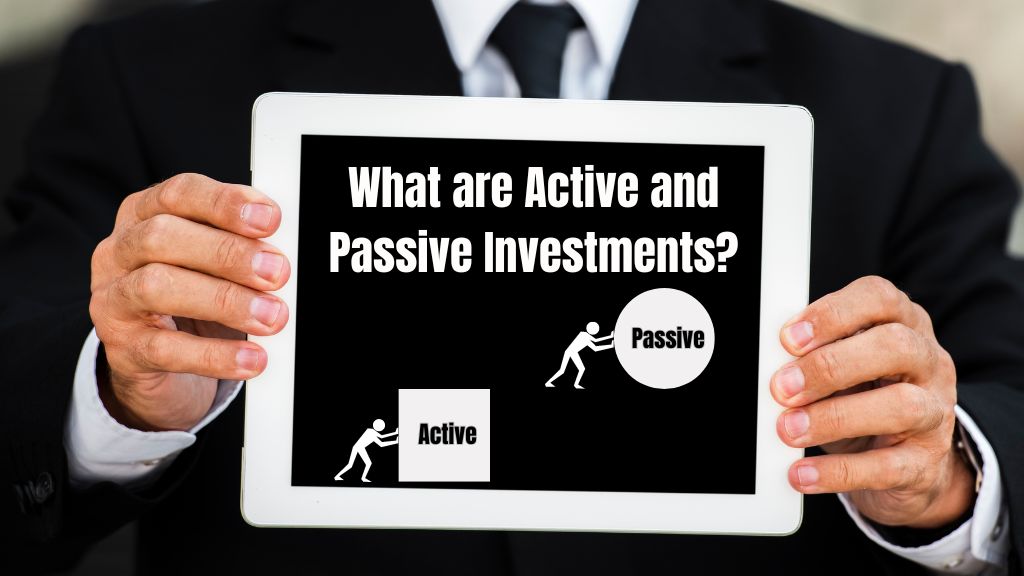If you lack basic investing knowledge, investing may seem difficult. However, if you have guidance? You can make wise investment decisions. Investment plans provide numerous choices to meet the requirements of diverse investor types and their financial objectives. These plans fall into two general categories: active investing and passive investing. If you are searching “What are active and passive investments?” on Google, this article satisfies your question.
Active investment means investors actively choose where to invest. Investors in passive investments try to copy a specific index or market. Each strategy has advantages and disadvantages. In this article, you will gain in-depth knowledge about what active and passive investments are:
Active Investment
Active investing involves managing your investments yourself, either alone or with the help of professionals. Active investors generally do not mind taking additional risks in the hope of achieving larger returns. Investors focus on making quick returns by buying and selling stocks or other assets regularly. They spend researching and analyzing market trends to make quick decisions to earn money in a shorter period.
In simple words, an Active investment strategy involves making investment decisions after proper research on assets. While some people prefer to manage their assets independently, others seek professional help. It might be somewhat expensive because you may have to pay for research or expert fees. However, if you handle it properly, you can increase your income.
Advantages and Disadvantages of Active Investment
Before organizing your investments, it’s essential to weigh several important factors, including active investment pros and cons. Consider your financial goals and risk appetite, which will assist you in deciding if the chosen plan aligns with your needs. There are several advantages and disadvantages to active investment.
Advantages
The following advantages of an active strategy can be achieved:
- The assets are not limited to the top performers of a particular group; investors and their managers can choose from a wide range of assets.
- Investors are free to create investment portfolios based on what they are aiming for or what they want in active investment.
- Investors in active investment have ways to protect themselves by using different methods, such as selling stocks they do not own or buying options that give them the right to sell later.
- Investors can sell certain stocks or industries if they wonder if the risks are very high in active investment.
- The active investment pros and cons portfolio can be changed according to the current market and trends.
- It is crucial to remember that managing your investments, including the buying and selling of assets, can reduce your tax liability. You can sell assets losing money to lower taxes on profitable investments.
Disadvantages
To understand active investment pros and cons is not suitable for everyone because it has a few disadvantages and limitations:
- Active investment is more expensive than passive investment. The average expense ratio for active managed funds is 0.68%, compared to passive investment, which is lower at 0.06%.
- The cause of the higher fees in active investments is regular buying and selling, which results in transaction expenses. These fees can significantly reduce your total return on investment over several years.
- Because fund managers are humans, they can make mistakes when investing. These mistakes may be costly. They are sometimes flawed in their decisions.
Passive Investment
Passive investing is the practice of buying and selling as little as possible. One of the most famous and commonly used passive investing methods in the market is indexing. This investment is different from active investing, where people buy and sell stock to grow money.
Index fund investors reduce their risk because it buys securities and lets them buy fund shares. The purpose of an investment strategy is not to beast the market; Rather, its purpose is to replicate the highs and lows of the index it tracks
Passive investing aims to avoid the high expenses and unclear returns associated with repeatedly buying and selling stocks. Its goal is to gradually accumulate wealth over time. This strategy is often referred to as a “buy and hold” plan. Passive investors do not try to predict market fluctuations, unlike active traders who aim to profit from sudden fluctuations in stock prices.
Advantages and Disadvantages of Passive Investment
It is a common strategy for growing wealth. Almost every type of financial asset, including stocks and indexes, can be used with this strategy. Here are a few advantages and disadvantages of passive investing that we are going to discuss:
Advantages
Here are the key advantages of passive investing:
- Since no one is actively picking and managing the stocks, the costs are very low. Passive funds just follow the index as a benchmark.
- Investors can always see exactly what assets are in an index fund.
- It is much easier to invest in and understand an index compared to a strategy that needs constant research and planning.
- This investment uses a buy-and-hold strategy, so you do not have to pay much in capital gains taxes.
- Passive investors buy ETFs or mutual funds, which are collections of a variety of investments, to reduce risk and increase growth.
- This investment can be adjusted for goals such as personal interests or retirement dates.
Disadvantages
Passive investment strategies have the following disadvantages:
- Investors who invest in passive investments are unable to move their holdings regardless of market fluctuations.
- Unless there is a big rise in the entire market, this investment usually matches the performance of the market and rarely exceeds it.
- Passive investment does not give investors any control over individual investment selection; instead, fund managers make all investment decisions.
Active vs. Passive Investment: Choose Which One Strategy is Better?
Investing can seem overwhelming. With so many options, strategies, and opinions out there, how do you know which one is right for you, between active and passive investment? The debate is one of the biggest in the financial world. But, here is the good news, you don’t have to choose sides. Instead, you can choose what works best for your goals, personal, and lifestyle.
Who is Active Investment for?
- Investors who enjoy researching and analyzing the market.
- Those who are comfortable taking on higher risk for the chance of higher returns.
- People who have the time and patience to monitor their investment regularly.
Who is Passive Investment for?
- For newcomers who are just beginning their journey in investment.
- Busy individuals who don’t have time to constantly monitor the market.
- Investors who prefer a low-cost, low-stress way to grow their money over time.
Active vs. Passive Investment: A Quick Comparison
The truth is, there is no better strategy, it all depends on your goals, risk appetite, and how involved you want to be. Here is a quick comparison of it:
| Aspect | Active Investment | Passive Investment |
| Management | Requires hands-on approach, frequent buying and selling | Buy and hold strategy, minimal management |
| Risk Level | Higher risk, Higher returns potential. | Lower risk, steady growth over time. |
| Time and Efford | Requires market research and quick decision-making. | Less effort, ideal for long-term investors. |
| Cost | Higher fees due to trading and management costs | Less effort, ideal for long-term investors. |
| Return | Potentially higher, but not guaranteed. | Less effort, ideal for long-term investors. |
Still unsure? Many investors combine both strategies to get the best of both worlds. For example, you might use passive investing for the core of your portfolio and active investing for a smaller portion where you are willing to take more risks.
Read More: Investment Journey: How Can One Start a Successful Investment Journey?
Conclusion
According to financial experts, the best strategy is to combine active and passive investing methods. This combination can help reduce large swings in stock prices. Advisors don’t have to choose just one approach. Combining the two investments can increase portfolio diversification and improve risk management.
Hopefully, This article provides you right knowledge in easy language about “What are active and passive investments?”, Whatever investment strategy you want to use, it does not matter if it is passive or active; both are ways to achieve your financial goals. It is always a good idea to assess your financial situation and determine how you are doing.
FAQs: What are Active and Passive Investments?
What is the difference between active and passive investments?
The major difference between active and passive investing is that active investing means constantly buying and selling stocks to beat the market, while passive investing requires infrequent trading and only seeks to match market returns.
Is passive investing safe?
It depends on the individual’s financial situation. Passive investing focuses on low-risk and long-term strategies. It is an important message from the financial expert that people should research before investing.
Does active investing have high risk?
Yes, active investing carries more risk because it involves repeatedly buying and selling stocks, which increases the high chance of losing money.
What is the goal of active investing?
The main goal of active investing is to achieve good returns that are higher than those selected targets or the overall market.

Hi everyone, my name is Sharda Kumari, founder of basicfinanceliteracy.com. My love for writing about finance comes from my personal experiences, including investing, saving, and learning from mistakes along the way. I share simple, easy, and honest articles on investing, saving, and financial planning. There is no complex language, no excessive advice, simply useful advice that anybody can follow.
My goal is to make financial literacy feel less like a complicated subject and more like a life skill we all deserve to learn. If you have ever felt lost trying to figure out where to start with money, you are not the only person who thinks like this, and now, you are in the right place.
Thanks for being part of this journey. Let’s grow wiser with money together.
